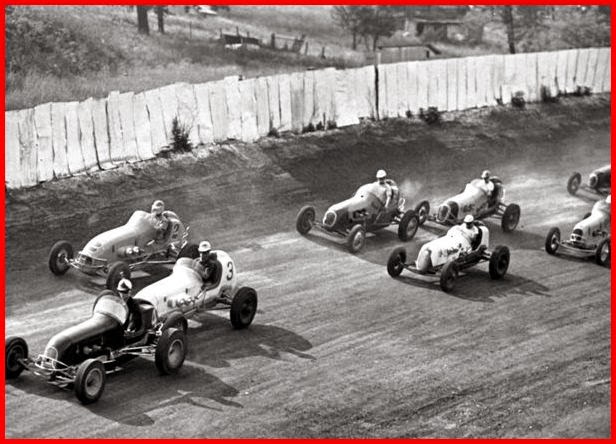This was the outside banked track, these were the Sprint Cars, the same ones that were running at Indy at the time. Many well knows drivers raced here.
They used to race Midget Cars on the inner track on Friday Night, Saturday and Saturday night, Stock Cars, and the Sprints on Sunday. I have seen cars go through that old wooden fence and end up in a cornfield or an open field. Safety was not a big issue in those days. Open Wheels, no roll cages, just a helmet. Great racing though.
"Dayton, Ohio has long been a hotbed of racing action, though it may not appear so today. Starting back in 1933 with the opening of the Dayton Speedway, a D shaped 5/8 mile track that copied the Ascott Speedway.
It opened with a childrens race in 1933, followed by it’s first official race on Sunday June 3rd. 1934. The winner of that first race was a gentlemen (who would go on to race at Indianapolis three years later, then again ten years after that), by the name of Ken Fowler.
The track operated for three years until it was redesigned in 1936 and on June 4th, more asphalt was added to the track, as well as the turns were modified in an attempt to make it the fastest D shaped track in the country. In 1937 the track was purchased by a gentlemen by the name of Frank Funk, he proceeded to convert the track to a high banked 1/2 mile oval. Twice the banked turns were raised to increase the speeds. The track was also prepped with an unknown substance that caused the track to ‘get as hard as asphalt’, however on hot days, the track became soapy and would cover the crowd and drivers. Rumors are trolley cars were buried to fill up space to help build the banked turns up. Though, that was never been proven and none have been found.
In the late 30′s, covered grandstands were added for the spectators comfort, and remained at the track until they were removed in 1970. Sometime in the early 1940, billboard signage was placed along the backstretch With the beginning of WW2, the track was closed from 1941 to 1945. With the end of hostilities and many of the racers back home, the track was reopened on Friday June 29th, 1946. The first event was the first ‘Big Car’ race held at night on the East Coast, (Ascott was the first in the world)."
The early "midgets" were just scaled down sprint cars, many with Offenhauser Engines. The did not run much during the war, and engines and equipment were hard to get right after the war. One car had a Johnson Speedy Twin Outboard Motor engine ... made an awful racket.
Sod Saunders. Eddy Sachs, so many drivers. Many worked in a factory during the day and on Friday night they drove midgets ..




